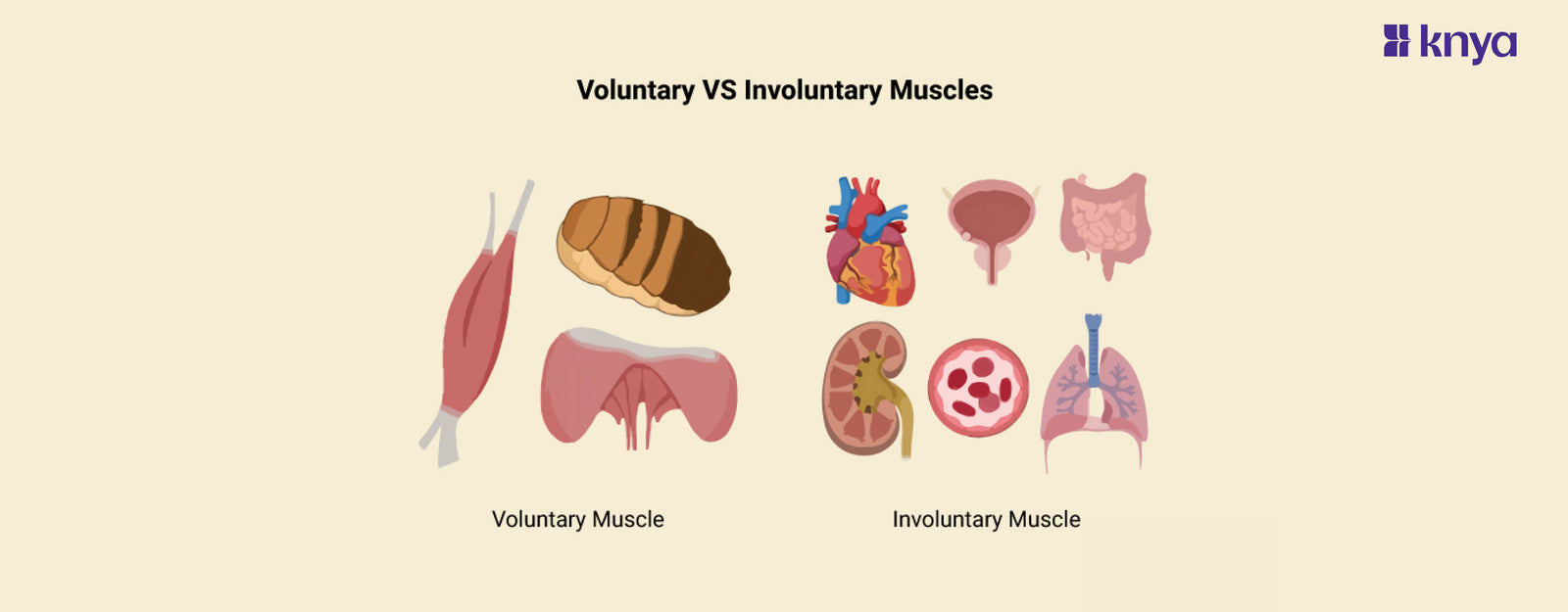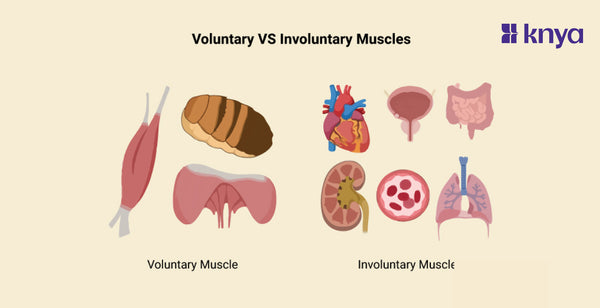Difference Between Voluntary and Involuntary Muscles: Our bodies have two main types of muscles: voluntary and involuntary. Voluntary muscles, like those in your arms and legs, are under your conscious control, allowing you to move and perform actions. They're typically striated, meaning they have a striped appearance under a microscope, and fatigue easily. Involuntary muscles, on the other hand, work autonomously, without conscious thought. They control essential functions like digestion, heartbeat, and breathing. These muscles are smooth, lacking striations, and can work tirelessly without tiring. Examples include the muscles in your stomach and intestines, as well as the heart muscle.
Difference Between Voluntary and Involuntary Muscles
Voluntary and involuntary muscles are two types of muscles in the human body that work and are controlled differently. outlined are some differences between voluntary and involuntary muscles.
|
Feature |
Voluntary Muscles |
Involuntary Muscles |
|
Control |
Under conscious control |
Not under conscious control |
|
Location |
Primarily in skeletal muscles |
Found in smooth and cardiac muscles |
|
Appearance |
Striated or striped appearance |
Smooth appearance without striations |
|
Nervous System Regulation |
Controlled by the somatic nervous system |
Controlled by the autonomic nervous system |
|
Conscious Awareness |
Movement is consciously initiated |
Movement occurs without conscious thought |
|
Fatigue Resistance |
Tend to fatigue more quickly |
Generally more fatigue-resistant |
|
Speed of Contraction |
Can contract rapidly |
Generally contract more slowly |
|
Location in the Body |
Predominantly attached to bones |
Located in various internal organs |
|
Regeneration Ability |
Limited ability to regenerate after injury |
Often have a greater capacity for regeneration |
|
Conscious Feedback |
Feedback about muscle status is consciously perceived |
Little or no conscious awareness of muscle status |
What are Voluntary Muscles?
Voluntary muscles, also known as skeletal muscles, are the ones you can control consciously. Think of them as the engine behind every move you make, from raising your hand to kicking a ball. They're attached to bones and work by contracting and relaxing, pulling bones together to create movement. These tireless workers are striated, meaning they have stripes under a microscope, and they fatigue easily, needing breaks to avoid getting overworked.
Key Features of Voluntary Muscles:
- Conscious Control: These muscles, like those in our arms and legs, respond to conscious commands from the brain. We directly control their contraction and relaxation, allowing us to walk, talk, wave, and perform countless other purposeful actions.
- Striated Appearance: Voluntary muscles have a striped appearance under the microscope due to their arrangement of protein fibers. This unique organisation enables their rapid and forceful contractions.
- Fatigue Prone: Voluntary muscles tire quickly with sustained use, requiring rest and recovery to function optimally. This is why you get tired after intense exercise!
- Limited Blood Supply: Compared to involuntary muscles, voluntary muscles have a relatively lower blood supply. This limits their endurance but allows for precise control and coordinated movements.
What are Involuntary Muscles?
Involuntary muscles, on the other hand, operate behind the scenes, keeping your body ticking even when you're not thinking about it. They work tirelessly without your conscious control, regulating vital functions like digestion, breathing, and heartbeat. These stealthy muscles come in two types: smooth muscles, found in your organs and blood vessels, and cardiac muscle, the powerhouse of your heart. They're unstriated and have amazing endurance, working continuously without tiring.
Key Features of Involuntary Muscles:
- Automatic Operation: These muscles, like those in our heart and intestines, function independently of conscious control. The nervous system and hormones regulate their activity, ensuring vital functions like digestion, breathing, and circulation continue seamlessly.
- Smooth Appearance: Unlike their striated counterparts, involuntary muscles appear smooth under the microscope. Their protein fibers are arranged differently, favoring sustained contractions over rapid bursts of power.
- High Endurance: Involuntary muscles can contract continuously for extended periods without fatigue, thanks to their efficient energy utilization and abundant blood supply.
- Limited Control: We cannot directly control involuntary muscles through conscious thought. However, some, like those in our airways, can be influenced indirectly through techniques like breath-holding or diaphragmatic breathing.
Shop Best Lab Coats from Here!
Similarities Between Voluntary and Involuntary Muscles
- Tissue of Muscle: Both are muscular tissues made up of muscle cells or fibres.
- Contractility: Both types of muscles can contract and create force.
- Functionality: Both serve in the general mobility and function of the body.
- Power Requirements: For contraction, both types of muscles require energy (ATP).
- Structure of the Cell: Myofilaments, which are responsible for muscle contraction, are found in both.
- Homeostasis: Both contribute to the body's equilibrium through numerous physiological processes.
- Blood Availability: Both categories receive a blood supply to give oxygen and nutrients while also removing waste.
- Skeletal System Interaction: Both work with the skeletal system to help with posture and mobility.
- Adaptation: Each can adjust physiologically in response to training or variations in demand.
The human body boasts two distinct types of muscle, each playing a crucial role in our movement and internal functions. While voluntary muscles like the biceps and quads respond to our conscious commands, allowing us to walk, dance, and hug, involuntary muscles like those in the heart and digestive system work tirelessly behind the scenes, independent of our will. This fundamental difference lies in the nervous system's control: voluntary muscles receive signals from the somatic nervous system, enabling conscious movement, while involuntary muscles dance to the tune of the autonomic nervous system, ensuring our vital organs function smoothly and unconsciously. This harmonious interplay between conscious and automatic control keeps us moving, breathing, and digesting, showcasing the remarkable complexity and adaptability of the human body.















